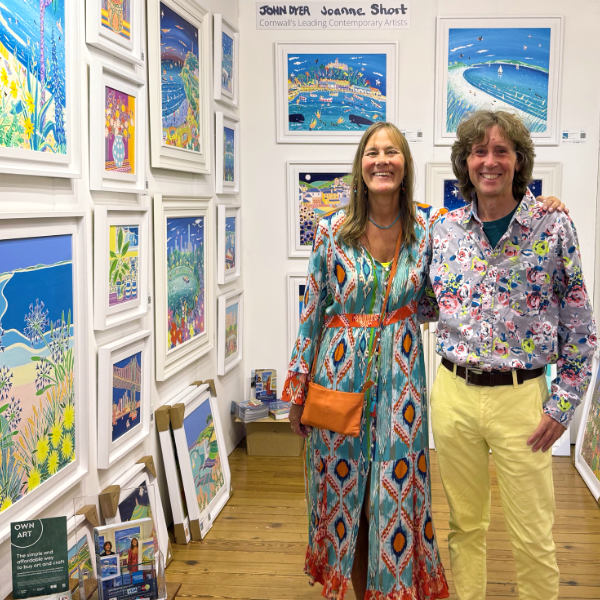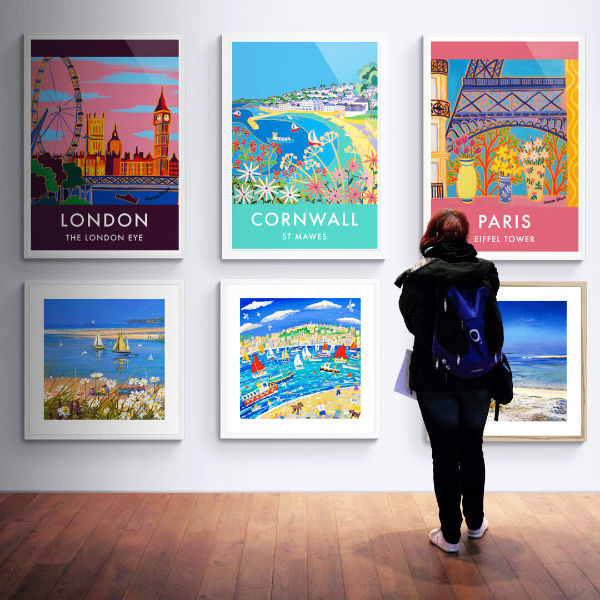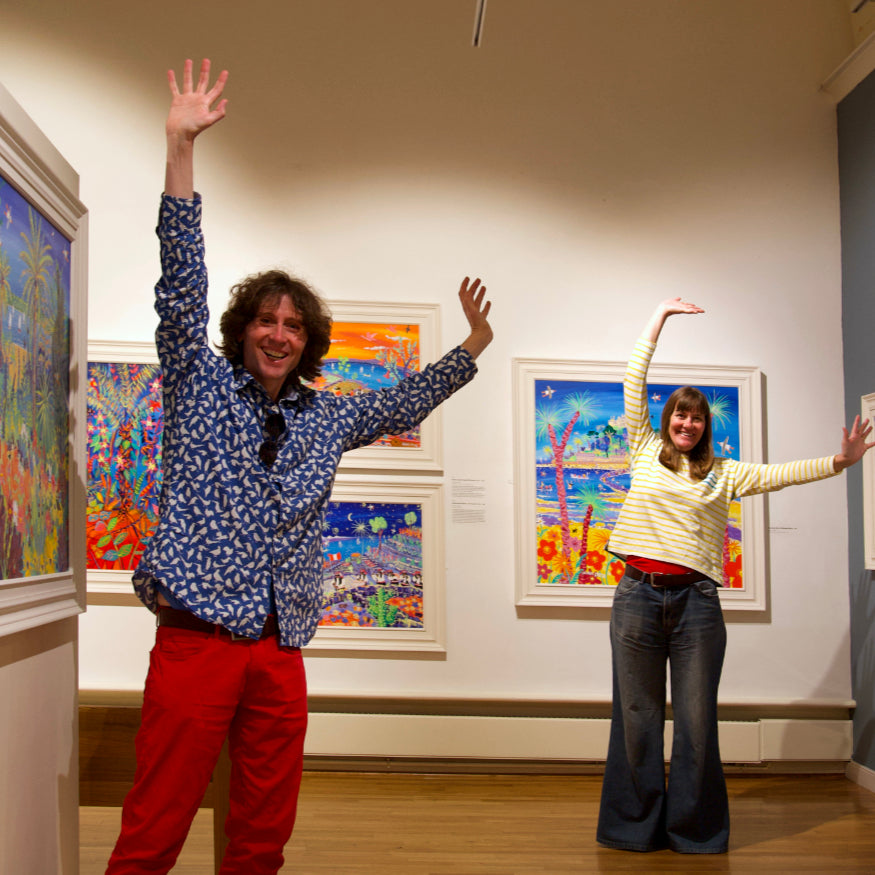Christmas Exhibition Paintings Live 10am Saturday 23rd November & Private View December 6th in St Ives!
Christmas Exhibition Paintings Live 10am Saturday 23rd November & Private View December 6th in St Ives!
Invest in British Art from Cornwall's Leading Artists | Free Worldwide Delivery
JOHN DYER
Original Paintings
New paintings available to buy online now by Cornwall's best loved artist.
JOANNE SHORT
Original Oil Paintings
New paintings available to buy online now by Cornwall's acclaimed colourist painter.
TED DYER
Original Oil Paintings
New paintings available to buy online by Cornwall's best known impressionist artist.
All Original Paintings
View all of the new original paintings that we have available to buy online now in our online gallery.
The ones you missed
View all of the recently sold original paintings by our Cornish artists John Dyer, Ted Dyer and Joanne Short.
Cornwall Art Prints
Museum-quality prints. Framed, Unframed, Signed & Wall Art Posters
Christmas Exhibition St Ives 2024
Private View: 6th December 6pm to 8pm
Exhibition continues: 7th - 8th
Summer Collection 2024
Online exhibition of new paintings by John Dyer & Joanne Short.
Easter Exhibition St Ives 2024
New paintings by John Dyer & Joanne Short in the historic Porthmeor Studios in St Ives.
Explore our Previous Exhibitions
Enjoy exploring our previous exhibitions and discover amazing paintings.
Art Collectors Club.
Enjoy 5% off your first order, regular offers, exclusive exhibition invitations and artist and gallery updates in our monthly email newsletter.
Leonardo da Vinci (1452-1519) embodied the ideal of the Renaissance humanist, despite being born into less fortunate circumstances. He was the illegitimate son of the notary, Piero da Vinci, and Caterina, a peasant woman named. He was born on the 15th April, 1452, in Vinci, Italy. Despite his humble beginnings, Leonardo's diverse talents became evident as he grew up in his father's home, where he received an informal education in Latin, geometry, and mathematics.
At around 15, Leonardo was apprenticed to the renowned artist Andrea del Verrocchio in Florence, where he gained a wide range of artistic and technical skills. During this apprenticeship, he worked on various projects and developed his creative style. One of his earliest works contributes to Verrocchio's "Baptism of Christ," where Leonardo painted an angel with such skill that it reportedly caused Verrocchio to abandon the painting.
Leonardo's career took him to Milan in 1482, where he entered the service of Ludovico Sforza, the Duke of Milan. During his time in Milan, he created some of his most significant works, including "The Last Supper" (1495-1498). This mural, painted for the refectory of the Convent of Santa Maria delle Grazie, is celebrated for its composition and the emotional depth of its characters. It captures the moment Jesus announces that one of his apostles will betray him.
Among Leonardo's most famous works is the "Mona Lisa" (c. 1503-1506), a portrait of Lisa Gherardini. The painting is celebrated for its enigmatic expression and skillful use of sfumato, a technique involving the blending of colors and tones. It is held in the Louvre Museum in Paris and remains one of the most renowned and frequently visited artworks internationally.
Leonardo's curiosity and innovative thinking were not limited to art. His notebooks, filled with sketches and notes, reveal a mind constantly seeking to understand the world. They contain designs for flying machines, a precursor to the modern helicopter, various war machines, and observations of natural phenomena. But perhaps his most groundbreaking work was in the field of human anatomy. His anatomical drawings, based on dissections he performed, were revolutionary in their detail and accuracy, contributing significantly to our understanding of the human body.
Leonardo spent his final years in France at the invitation of King Francis I, who provided him with a manor house, the Château du Clos Lucé, near Amboise. Leonardo continued to work on various projects until his death on May 2, 1519. He was buried in the chapel of the Château d'Amboise.
Leonardo da Vinci's influence is not confined to his era. His legacy, marked by his masterpieces and his vast contributions to art, science, and engineering, continues to shape our world, cementing his status as one of history's greatest minds.
Explore our main art collections to find perfect original paintings, limited edition signed prints, open-edition prints, wall art prints and posters & artist designed gifts.
N.B. If you don’t see your confirmation email shortly, please check your spam or junk folder.
A lovely art print bought as a memory of our holidays on the beautiful Isles of Scilly.
The frame is very well made and displays the art print beautifully. Ordering from John Dyer Gallery was simple and delivery swift. I would not hesitate to order from them again.
Thank you so much for the amazing customer service, and most beautiful painting of our favourite place
Absolutely beautiful painting. So thrilled with it. Completely amazing service: beautifully packaged, framed and safely delivered really quickly.
Lovely picture, bought 3 after our recent trip to Cornwall. Already thinking of getting more.
Have walked this coastal path from St Agnes to Chapel Porth and back countless time. I am now pleased that this fabulous print is the first thing I see every morning. Beautiful, happy colours. Nice frame. I’m now planning of ordering one of Mount’s Bay by same artist.
Such a vibrant, pretty piece. I visited Fowey Harbour recently and was looking for a small keepsake to have with me back in the U.S. Shipping abroad was seamless and I received this item quite quickly. I've had many compliments since putting this on my phone and am happy to be reminded of a wonderful trip to a magical place this summer.
As always professional , efficient and prompt .
We have been coming here for 27 years together. This is our place especially during lockdown. John has captured our place beautifully. I have many of John’s prints, always in my birthday, so this one for June is 😍 perfect. They always make me smile, colourful, fun and look perfect in our home
I found the whole experience flowed from start to finish. The customer service was exceptional, they couldn’t do enough for me. This is the kind of first rate service I would expect from such a professional artist. Thank you.
Lovely,bright and colourful ready to hang.
Bought back lovely memories.
Posted promptly too.
Thank you.
I have loved John Dyers work for many years. I have some prints at home and at work.
Gorgeous, vibrant colours. Reminds me of many happy evenings at the Minack when growing up in Cornwall. Special memories.
great service. Thank you.
I purchased “Bathing Belles” to add to 2 other John Dyer original paintings collected over the years .
We decorated our house and removed another trio of prints , so were hoping to find something suitable at John’s latest exhibition.
We were not disappointed . The colours are vivid and the painting has elements of my childhood : a trip on the Enterprise boat , snd swimming in the sea . There is also a signature seagull (oh how I love those seagulls !!) a chough , a puffin and a friendly seal . I like the play on the words in the title, with bluebells in the foreground .
The off white frames complement the colour palette perfectly .
I was extremely impressed on how quickly the painting was delivered after the exhibition - I had expected to wait at least a couple of weeks , but within days it was with me . As always it was packaged very carefully .
Stripy Swimmers is a joyous riot of exquisite colours and shapes. It has pride of place in my sitting room. Every day it lifts my spirits and energizes me to be creative myself. Thank you Joanne, your unique painting has a very happy home. Thanks also to you John for your expert eye - the frame perfectly enhances the explosion of colour. It was so robustly packaged I wouldn't hesitate to buy from the gallery again knowing that it will arrive safely. I am a very Happy Customer!
We have loved and been visiting Holywell bay for over 25 years. It's a real home from home for us. This picture captures the place for us perfectly.
The paper is such good quality, certainly worth the cost. Delivery was effortless.
WOW Environmental inspired art at it's best.Bright and bold and mesmerising. John Dyer was very easy to contact and accommodating with dates for shipping




